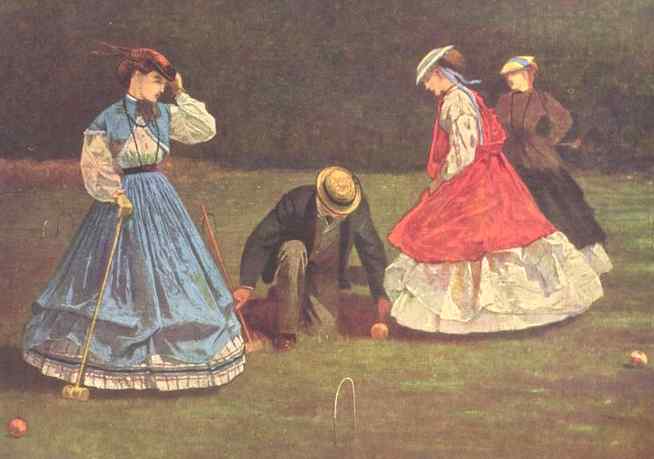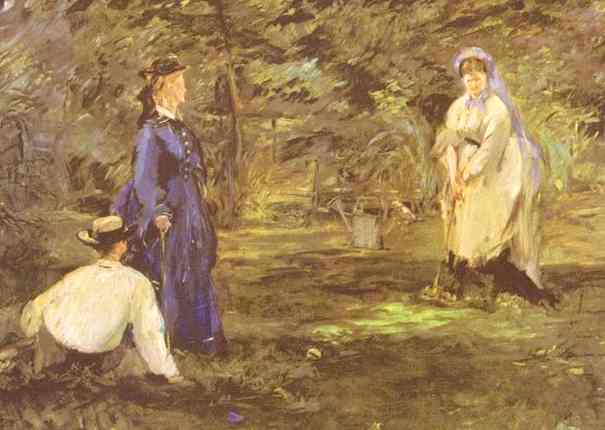|
CROQUET
|
||
|
Croquet is a recreational game and, latterly, a competitive sport that involves hitting wooden or plastic balls with a mallet through hoops embedded into the grass playing arena.
The game was apparently invented in Ireland in the 1830s as a distant cousin of golf and taken to England as a pastime of the aristocracy in the 1850s. It may have evolved from the earlier mallet and ball game pall mall.
It made its way to Canada, the United States, Australia, and France, and while never hugely popular has continued to maintain a substantial following.
Croquet by Winslow Howard
Competitive croquet
Croquet was an event at the 1900 Summer Olympics and Roque, a variation on croquet, an event at the 1904 Summer Olympics. One of the best known croquet clubs is the All England Lawn Tennis and Croquet Club, originally the All England Croquet Club, which hosts the annual Wimbledon tennis championships.
There are several variations of croquet currently played, differing in the scoring systems, order of shots, and layout (particularly in social games where play must be adapted to smaller-than-standard playing courts). Two forms of the game, Association Croquet and Golf Croquet, have rules that are agreed internationally and are played in many countries around the world. More unusual variations of the game include Mondo Croquet, eXtreme Croquet, and Bicycle Croquet.
As well as club-level games, there are regular world championships and international matches between croquet-playing countries. The sport has particularly strong followings in the UK, USA, New Zealand and Australia. Many other countries also play.
Some people consider croquet to be viciously competitive. However, the ability in versions other than Golf Croquet to gain extra strokes favour players who position balls with more care, rather than simply as far away from everything else as possible. At championship standard Association Croquet, players can often make all 26 points (13 for each ball) in two turns.
Association croquet
In Association Croquet players can take multiple shots in one turn provided they either a) hit the ball through the correct hoop ("run" a hoop), or b) hit another ball. Upon hitting another ball, the player must play his next shot with the two balls touching; the "Croquet Stroke", from which the game takes its name. The winner is the player who, with each of his balls, runs each hoop twice in order and strikes the centre peg.
As long "breaks" (continuous play by one player) became more common as the standard of play improved, "Advanced Play" (a variant of association play for expert players) was introduced. This gave penalties to a player who ran certain hoops in the same turn. In response, feats of skill such as triple peels and even sextuple peels, in which the partner (or opponent ball) was caused to run a number of hoops in a turn by the strikers ball, became more common in order to avoid the penalties.
Over the years, Association Croquet has become highly sophisticated giving rise to innovative strokes such as the Von Schmieder Sweep This is a novel stroke played on a hoop-bound ball when it lies about 9-14" directly behind the hoop. It allows you to roquet a reception ball lying further behind the hoop. The stroke is played with the mallet held horizontal with the shaft 2-3" off the ground. The ball is believed to be pulled in towards the striker rather than travel along the tangent to the sweep.
The current (August 05) Association Croquet World Champion is Reginald Bamford (RSA). The UK recently won the MacRobertson International Croquet Shield, the major international trophy in Association Croquet.
Croquet by Edouard Manet
Backyard croquet
Croquet has become a popular backyard game in Canada and America, where croquet sets are commonplace in most department stores and sports shops. Such sets typically consist of 6 wooden mallets with plastic bumpers on both striking surfaces. The mallet head and handle usually come unassembled and are joined by screwing the handle into the head. The 6 balls are either of wood or, more commonly, plastic. They are coloured blue, red, black, yellow, green and orange. Also included are 9 wire wickets and two wooden stakes. There is often a carrying case or stand with the set.
Setup is just as in standard 9-wicket rules. It is a double-diamond pattern formed by 7 wickets, with the middle wicket serving as a shared point for both diamonds. Beyond the wickets at either end are one additional wicket and one stake. The diagram included with the set indicates that there is to be a 6 foot distance separating the wickets at the outer end of each diamond, and 6 more feet between the outermost wickets and the starting and turning stakes. In practice, however, this part of the diagram is typically disregarded, and a mere "mallets-head-length" (about 10 inches) separates one wicket from the other, and the outermost wicket from the stake. This allows the ball to more easily be hit through both wickets in one stroke.
The standard game is "cut-throat," with each player trying to beat all the others through the course to the final stake. A player's score is disregarded. Instead, the game is considered a race. The game is sometimes considered over as soon as the first player strikes the final stake. Alternatively, players continue playing for second place, third place, etc., until only one player's ball remains.
Play order is determined by the order of the stripes painted from top to bottom on the stakes. The mallets are sometimes also painted in multicoloured stripes to remind players of the playing order. The usual order is blue, red, black, yellow, green, and finally orange. After orange is done, play continues with blue again. This order sometimes varies, depending on the set being used.
The first player begins by setting his or her ball beside or in front of the first stake. The player then attempts to strike the ball through the first two wickets. Though disallowed in some yards, players might sometimes use the technique of striking the ball not with the end of the mallet, but with the side, or even shoving it with the side, rather than striking it. Another technique disallowed in some yards, but tolerated in others, is to set the ball in direct contact with the stake, and to propel it by striking the stake, rather than the ball itself.
A bonus stroke is granted for each wicket the ball goes through. At the starting and turning stakes, two bonus strokes would be granted for getting the ball through both wickets in one stroke.
Two bonus strokes are also granted for hitting another ball. Hitting a ball cancels out all bonus strokes accumulated from wickets, and going through a wicket cancels all bonus strokes accumulated from hitting a ball. A player can therefore acquire no more than 2 bonus strokes at a time. If a player hits another ball, that player is considered "dead on" that ball, and can acquire no more bonus strokes from hitting that ball until he or she has gone through the next wicket (or struck the next stake) in the course.
After hitting another ball and gaining bonus strokes from it, a player has three choices as to ball placement. The player may play the ball where it lies, pick up the ball and place it right next to the struck ball, or pick up the ball and place it one mallets-head-length away from the struck ball.
If the ball is placed right next to the struck ball, the player may "send" the other ball by placing a foot on his or her own ball and then striking it so as to send the other ball away. Care must be taken not to unintentionally send one's own ball during this manoeuvre, and not to injure one's own foot with an overzealous and poorly aimed swing. Holding the ball in place with a hand, rather than a foot, is also acceptable in some yards. A "send" counts as one stroke, and the player has one more stroke after performing it.
Players must play their balls through the wickets in a certain order. From the starting stake and the first two wickets, they proceed forward and right to the third wicket, then forward and left to the fourth, middle wicket, then forward and right to the fifth wicket, then forward and left to the sixth and seventh wickets, and then to the turning stake. After striking the turning stake, the player may pick up the ball and place it again in the same manner as with the starting stake, or else play it where it lies. The player then proceeds back through wickets 7 and 6, in that order, then forward and right to the eighth wicket, then forward and left to the fourth, middle wicket (going through the other direction, this time), then forward and right through the ninth wicket, then forward and left through wickets 2 and 1 in that order, and finally striking the starting stake to win the game. Players do not get bonus strokes for going through a wicket backwards, or out of the proper order.
There are as many variations on these rules as there are yards in which the game is played, and care must be taken to make the "house rules" clear before the start of the game.
One popular variation is "Poison" or "Snake" rules. In this game, a ball that reaches the starting stake again is considered a Snake, or Poison. This ball "kills" or eliminates other non-poisonous balls from play if it strikes them, or is struck by them. If a Snake hits another Snake, the struck Snake is killed. If a Snake hits a stake or goes through a wicket in any direction, it is killed. If a non-poisonous ball strikes a poison, it may do the same things as if it had hit another ball. That includes sending the poison through a wicket, killing it. The last player on the course wins the game. Just as with regular balls, a Snake gains 2 bonus strokes for hitting another ball.
Another variation is team play, where pairs or trios of players compete against other teams to be the first with all members completing the course. Teams are typically blue, black and green versus red, yellow and orange. In couples play, it is blue and black versus red and yellow, or blue and yellow versus red and green versus black and orange.
Yet another variation is "Obstacle" or "Golf" rules, in which players must go through a unique course of wickets that has been designed to be long and difficult. Wickets are often placed in inconvenient spots, such as under bushes or on the sides of hills. The idea here is to maximize originality and absurdity, and there are often numerous additional rules toward this aim, such as the rule that you may not take a stroke without a drink (preferably alcoholic) in your hand.
The United States Croquet Association (USCA) is the governing body of croquet in the United States. The Official USCA 9 Wicket Croquet Website is http://www.9wicketcroquet.com
LINKS and REFERENCE
A - Z SPORTS INDEX
A taste for adventure capitalists
Solar Cola - a healthier alternative
|
||
|
This website is Copyright © 1999 & 2020. The bird logo and name Solar Navigator are trademarks. All rights reserved. All other trademarks are hereby acknowledged. Max Energy Limited is an educational charity. |

